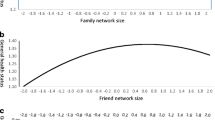Abstract
Background According to the buffer hypothesis, social support or social network may affect mental health by buffering the negative effect of stress on mental health. Previous studies have mostly been cross-sectional or have been done on selected populations, and the results have been conflicting. Methods The buffer hypothesis was tested in three population-based health surveys which took place in 1987, 1990 and 1993 in five coastal municipalities in Finnmark, Norway. All persons aged 40–62 years and a random sample of those aged 20–39 years were invited, and 77 %, 74 % and 70 % attended the three health surveys, respectively. Those who had attended the health surveys more than once and had answered the key questions about mental health and social network, social support (measured both as instrumental support as well as emotional support) and stress were included in the analyses. Stress was divided into acute stress, (somatic stress, civil stress and work stress) and chronic stress (having a chronic disease, disability pension, being a single parent or providing long term nursing care for someone in the family). Growth curve analyses using mental distress as the dependent variable were used, analysing the interactional effects of various types of stressors and social network or social support. Results When all possible stressors and the sum of social network/social support were taken into consideration, total social support/network buffered the deteriorating effect of total stressor score upon mental health. The effect was weak but significant, and stronger for women than men. When each stressor was analysed separately, only a significant buffer effect of social network could be detected for work stress. For one of the chronic stressors, receiving a disability pension, a buffer effect could be demonstrated for both social network and instrumental support. Conclusion The results provide some support for the buffer hypothesis, and indication of specificity in the interactions between stressor and social network/social support was found. Women, in general, had a larger buffering effect from their social network than men.
Similar content being viewed by others
Author information
Authors and Affiliations
Additional information
Accepted: 5 September 2001
Rights and permissions
About this article
Cite this article
Olstad, R., Sexton, H. & Søgaard, A. The Finnmark Study. A prospective population study of the social support buffer hypothesis, specific stressors and mental distress. Soc Psychiatry Psychiatr Epidemiol 36, 582–589 (2001). https://doi.org/10.1007/s127-001-8197-0
Issue Date:
DOI: https://doi.org/10.1007/s127-001-8197-0





